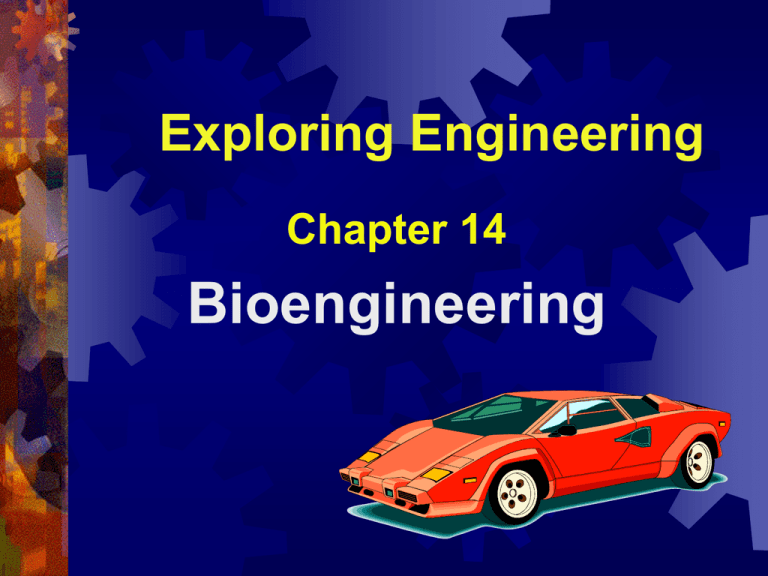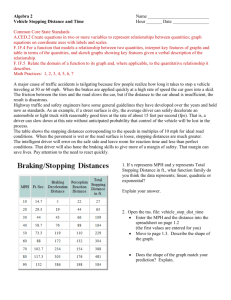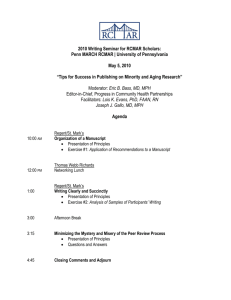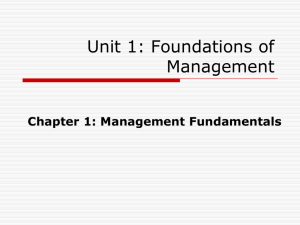The Engine Control Computer
advertisement

Exploring Engineering Chapter 14 Bioengineering Topics to be Covered What is bioengineering? Impact damage to the human body Fracture criterion Injury potential Gadd Severity Impact Parameter Examples What is Bioengineering? Bioengineering applies engineering methods and techniques to problems in biology and medicine. Biology Tissue Engineering Neural Implants DNA Expression Arrays Medicine Engineering Pumps Pacemakers Prosthetics Neural Engineering Neural Engineers use modeling and analysis to understand and control the nervous system. Advances in neuroscience and microfabrication have opened the doors to exciting applications in neuroprosthetics, biosensors and hybrid biocomputers. Fluorescent Stained Myocyte Microfabrication Surface Cell and Tissue Engineering Cell and Tissue Engineering allows one to repair or replace the function of natural tissue with bioengineered substitutes. Principles of engineering, chemistry, and biology are combined to create tissue substitutes from living cells and synthetic materials. New Companies: Advanced Tissue Sciences, Inc. Organogenesis Tissue Engineered Skin Bioinformatics & Genomics Bioinformatics combines computer science with biomedicine to develop tools for identifying and understanding the genetic blueprint of life. Genome Annotation (DNA sequence identification of genes) Discover genetic basis for disease (cancer, diabetes) Develop new diagnostic devices (cDNA chip) cDNA Array Future of Bioengineering Human Genome Sequence Heart Cell Regeneration Pre-implantation Genetic Diagnosis Bioinformatics Bio-Molecular Modeling Genetic Engineering of Animals Genetic Engineering of Proteins, Drugs Cell and Tissue Engineering Neural Engineering Biomaterials Accelerations That Kill High speed doesn't itself produce harmful injuries, but high acceleration or deceleration can be fatal. The common term "g" is a measure of acceleration. Everything is said to feel normal at 1 g, twice as heavy at 2g, and weightless at 0 g. One standard for sudden impact acceleration on a human that would cause severe injury or death is about 65 g's. Military aircraft are so fast and nimble that evasive maneuvers can add 9 times the acceleration of gravity (or 9g's) to the weight of a pilot's body. It can cause fatigue, blackout, or death as gravity drives blood and oxygen from the brain, lungs, and heart. Planes, Cars and Coasters Aircraft, car crashes, and roller coaster rides are common examples of high g situations. Roller coasters undergo a maximum of 3 to 4 g's for brief periods. Military pilots may be exposed to 9 g's for short periods of time. An acceleration of 4 to 6 g's is held for more than a few seconds could result in blackout or death. The car crash of Princess Diana of Wales in 1997 produced between 70 - 100 g's. In 1985 Sammy Miller set the fastest 1/4 mile time to date of 3.58 seconds at 386 mph in his Vanishing Point rocket car. His average acceleration over the quarter-mile was 4.6 g’s. Car Racing The British Ultima GTR accelerates from 0 to 60. mph in 2.6 secs, and from 0 to 100. mph in 5.30 secs. The average acceleration is aavg.= ΔV/Δt so, ΔV = [60 - 0 miles/hr](5280 ft/mile)(1 hr/3600 s) = 88 ft/s So aavg:0-60 = (88 ft/s)/(2.6 s) = 33.8 ft/s2 and since g = 32.2 ft/s2 in the English unit system, aavg:0-60 = 33.8/32.2 = 1.05 g, and aavg:0-100 = 147/5.30 = 27.7 ÷ 32.2 = 0.86 g This car also brakes from 100. to 0 mph in 3.60 seconds, which produces a deceleration (negative acceleration) of aavg:0-100 = (0 – 147)/3.60 = - 40.7 ÷ 32.2 = -1.26 g Rocket Cars Phenomenal times of 0-60 mph in 0.2 seconds and 0100 mph in 0.3 seconds are normal for rocket cars. They produce accelerations of 14 - 15 g’s. Sammy Miller’s rocket car had around 25,000 hp and did 0-60 in 0.16 seconds (17 g’s). He had to lie almost flat on his back in the car; otherwise, the incredible acceleration would have caused him to black out. He said that every time he raced the car his nose and ears bled. The Fastest Ever The fastest ever quarter mile was run by Kitty O’Neil in the ‘The Conklin Comet’ at El Mirage in California in 1977. She achieved 412 mph with an elapsed time of 3.235 secs. The car is a hydrogen peroxide fuelled rocket dragster with a engine producing 7,500lbs of thrust. Danica Patrick Makes IndyCar History Danica Patrick became the first female winner in IndyCar history April 20, 2008, taking the Indy Japan 300. Patrick finished 5.8594 seconds ahead of polesitter Helio Castroneves on the 1.5-mile Twin Ring Motegi oval after leader Scott Dixon pitted with five laps left and Dan Wheldon and Tony Kanaan came in a lap later. The 26-year-old Patrick won in her 50th career IndyCar start, taking the lead from Castroneves on the 198th lap in the 200-lap race. At the 2005 Indy 500, she nearly won the pole and became the first female driver to lead the race en route to a fourth-place finish. It was the best finish by a woman at Indy, and helped her take rookie of the year honors. Forensic Engineering Forensic engineering is the investigation of materials, products, structures or components that fail or do not operate/function as intended, causing personal injury or damage to property. The consequences of failure are dealt by the law of product liability. The subject is applied most commonly in civil law cases, although may be of use in criminal law cases. Generally the purpose of a forensic engineering investigation is to locate cause or causes of failure with a view to improve performance or life of a component, or to assist a court in determining the facts of an accident. It can also involve investigation of intellectual property claims, especially patents. The Human Nervous System Brain Injuries Due to Whiplash Stress-Speed-StoppingDistance-Area (SSSA) Criterion Suppose a body of mass m is subjected to a deceleration of ‘a’. Then the force experienced by the body = mV2/2DS. (Stopping distance = DS) Now suppose that this force is experienced as the contact of an area A of the head or body with a surface. Then the stress can be calculated as follows. Stress, = mv2/2ADS This useful relationship may be called the stressspeed-stopping-distance-area (SSSA) criterion. It states that, technically, it’s not enough to say that “speed kills”. What kills is the combination of high speeds, short stopping distances, and small contact areas! v= Note: a = v/t then F = ma = mv/t. Since the area under the V – t plot is Ds, then Ds = ½ Vt, and t = 2Ds/V and F = mV2/2Ds Area = Ds V 0 ts t t How Many g’s? The human body should not be subjected to more than 30. g’s. Above 30. g’s the damaging effects of acceleration or deceleration on the human body can range from loss of consciousness to ruptured blood vessels to concussion to the breaking of the bone and to trauma or death. The 30 g criterion serves as an initial rule of thumb for the design of safety devices. However, very high decelerations, measured in hundreds of g’s, can be survived - if the exposure is short enough. Deceleration at moderate g levels, on the other hand, can prove fatal if the exposure is long enough. Injury Criterion An unconscious 8 weeks old infant was admitted to a hospital and found to have bilateral, subdural and retinal hemorrhages. He died the following day. The parents explanation for the infant’s injuries was that the infant had been in a baby-rocker and that they had seen the rocker being rocked vigorously by their 14 months old daughter on two separate occasions. A biomechanical analysis of the infant in the babyrocker was used to estimate the maximum forces generated. These forces were then compared with those necessary to cause the subdural hemorrhage. Conclusions An instrumented infant dummy placed in a child rocker was subjected to a series of rocking impulses, applied by both a young child and an adult. A range of physical parameters was recorded and calculated. Head injury models were derived from dummy simulations based on animal experiments and mathematical modeling, accident investigation and reconstruction, adult volunteer and cadaver studies. The experiments do not support the account offered by the parents that the injuries suffered by the infant were sustained in the baby-rocker in the manner described. Mathematical Model: The Gadd Severity Index (GSI) The Gadd Severity Index was developed with data from tests on human cadavers, and supported with real accident data. GSI = a2.5tS where tS is the duration of the impact in seconds, and a is the deceleration in g’s. A human head can sustain values as high as 1,000 without serious injury as long as the peak value does not last for more than 10 or 15 milliseconds. For comparison, a hammer hitting a nail into wood gives a value of about 3,000, a baseball hitting a concrete wall is about 10,000, and a hammer hitting a concrete wall is about 3,600,000. Average acceleration, g 1,000 Experimental Points 300 GSI is the equation of this line 100 30 10 3 1 .001 .01 .1 1 10 Duration, s 100 1000 Text Example 1 A car traveling at 30. miles per hour runs into a sturdy stone wall. Assume the car is a totally rigid body that neither compresses nor crumples during the collision. The wall “gives” a distance of DS = 0.03 meters in the direction of the collision as the car is being brought to a stop. Assuming constant deceleration, calculate the deceleration. t=0 V = 30 mph 0.5 m 0. 5 m V = 0 mph t ==t s 0.47 m After impact, seconds later Just before impact v= V =13.4 m/s Speed Initial state– Area = Stopping distance DS = 0 .03 m 0 tss t Text Example 1 Continued Need: Deceleration = ____ m/s2 Know - How: First sketch the situation to clarify what is occurring at the impact. Then use speed - time graph to model the collision. The slope of speed - time graph is acceleration. Solve: We first need to calculate the stopping time, ts , to decelerate from 30. mph (13.4 m/s) to 0. From Chapter 10, if deceleration is constant, we know that distance equals the area under the V – t graph or DS = 0.03 [m] = ½ 13.4[m/s] ts [s] where ts is the stopping time. Therefore ts = 0.06/13.4 = 0.0045 s. Also the deceleration rate is the slope od the V-t graph, V/t = (0 - 13.4)/ (0.0045 - 0) = -2980 = -3,000 m/s2 (about 306 g’s) Text Example 2 The car and its belted driver of Example 1 suffers the same constant deceleration of 306 g (or ~3,000 m/s2). What is the force he or she experiences during the collision if their mass is 75 kg? Assume the car is a totally rigid body that neither compresses nor crumples during the collision. DS 30 mph Text Example 2 Continued Need: Force stopping 75 kg driver on sudden impact in SI. Force = _____ N Know: The driver’s weight is 75 [kg] 9.8 [m/s2] = 735 N and deceleration rate is 306 g. How: F = ma = mg a/g Solve: F = 735 306 = 2.24 105 N (or ~50,000 lbf!). Even though the driver is belted in position, this is a very substantial force. What are the effects on human tissue of such large forces? Structure of the Body’s Long Bones Dense outer bone layer Femur Marrow channel Sectional view Compact and spongy bone (made up of osteoblasts, collagen, and calcium phosphate) Bone Mechanical Properties 125 MPa 100 Longitudinal 75 Transverse 50 25 0 5 10 15 20 e 10-3 25 Seat Belts & Crumple Zones 30 mph 30 mph A 30 30mph mph 30 mph B V=0 v= 0 C The purpose of a seat belt is to attach the driver to a rigid internal passenger shell while the rest of the car shortens by crumpling. A seat belt is most effective when a car significantly crumples during a collision. Crumple Zone The crumple zone is the area of a car designed to absorb energy upon impact. Engineers deliberately place weak spots in a car's structure to enable the metal work to collapse in a controlled manner to direct energy from the impact from the passenger area, and channeled to the floor, bulkhead, roof, or hood. Energy from the impact is converted into heat and sound (loud noise). Crumple Zone Crash bunny Late night! Exercise A car is traveling 30. mph hits a wall. The car has a crumple zone of zero and the passenger is not wearing a seat belt. The passenger’s head hits the windshield, and is stopped in the distance of 0.10 m. The area of contact of the head and the windshield is 0.010 m2. 1) Provide a graph of V - t and F - t of the skull with the windshield. 2) If the compressive strength of bone is 3.0 106 N/m2, will the collision break the skull? Exercise 1 Solution Need: V - t graph of the collision and F = _____ N Know: v = 30. mph = 13.4 m/s; Ds = 0.10 m and A (contact) = 0.010 m2. Skull mass = 5.0 kg. How: V-t graph area relates to Ds and hence the time of impact. This gives the deceleration and thus the acting force. Solve: Ds = ½ V0 × ts; hence ts = 2 × 0.10/13.4 [m][s/m] = 0.0149 s. (Constant) deceleration rate = V0/ts = 13.4/0.0149 [m/s][1/s] = 899 m/s2. Force on head at contact is m × a = 5.0 × 899 [kg][m/s2] = 4490 = 4,500 N and lasting 0.015 s. 13.4m/s V 0 Force, N Ds= ½ V0 × ts 4,500 = 0.10 m ts t 0 t, s ts = .015 s Exercise 2 Solution Need: Max allowable stress on skull exceeded = _____ (yes/no) Know: Contact area = 0.010 m2 and force is 4,500 N. Compressive Strength of head bone = 3.0 × 106 N/m2. How: Compute force per unit area (which is the same as the energy per unit volume) of collision, and compare to compressive strength of head bone. Solve: Force = 4,500 N, so Force/Area = stress = 4,500 /0.01 [N][1/m2] = 4.5 × 105 N/m2 (which is less than the compressive strength of bone, so no, the skull will not be broken, but other very serious injuries may still occur within the head or neck). Another Exercise A rear facing child safety seat holds a child of mass 12 kg rigidly within the interior of a car. The area of contact between the seat and the child is 0.10 m2. The car undergoes a 30. mph collision. The car’s crumple zone causes the distance traveled by the rigid interior to be 1.0 m. Give the stress experienced by the child’s body in terms of a fraction of the breaking strength of bone assuming an infant’s bone breaks at a stress of 10. MN/m2. Child Exercise Solution Need: Stress experienced by child’s body = ____ ÷ breaking stress of bone. Know: Impact at 30. mph = 13.4 m/s; deceleration distance = 1.0 m and contact area = 0.10 m2. Breaking stress in infant’s bone = 10. MN/m2. How: Find duration of accident tf from V – t diagram. Find deceleration from V0 and tf. Find force from F = ma and find stress from force/area. Compare to breaking stress of 10. MN/m2. Solve: From V – t diagram, 1.0 m = ½ ×13.4 × tf [m/s][s] so that tf = 2.0/13.4 = 0.15 s. Hence deceleration rate for infant = 13.4/0.15 = 90. m/s2. Force on baby = 12. × 90. [kg][ m/s2] = 1.08 × 103 N. Stress = 1.08 × 103/0.10 = 1.08 × 104 N/m2. As fraction of breaking stress, 1.08 × 104/ 10. × 106 = 1.08 × 10-3 Bones should hold and infant should be safe. One More Exercise A car strikes a wall traveling 30. mph. The driver’s cervical spine (basically the neck) first stretches forward relative to the rest of the body by 0.01 m, and then recoils backward by 0.02 m, as shown below. Assume the spine can be modeled by a material of a modulus E = 10. GPa and a strength of 1.00 102 MPa. Will the maximum stress on the cervical spine during this “whiplash” portion of the accident exceed the strength of the spine? The length of the cervical spine is 0.15 m. V = 30. mph T1 Before stopping V=0 V < 30. mph T2 While stopping T3 After stopping Exercise Solution Need: Stress on cervical spine = _____ (greater than/equal to/less than) tensile strength of spine? Know: V0 = 30. mph = 13.4 m/s; cervical spine length = 0.15 m. During stopping period, T2, spine stretches forward 0.01 m and on stopping at T3 backwards by 0.02 m. Elastic constants are E = 10. GPa and “transverse” strength of 1.00 × 102 MPa for this failure mode. How: Compute stress on spine from its strain. Compare to its strength. Solve: Maximum stretch of cervical spine = 0.02 m. Maximum strain of spine = 0.02/0.15 [m][1/m] = 0.133 Stress on cervical spine = modulus × strain = 1010 × 0.133 = 1.3 × 109 N/m2. Compare maximum stress on spine to tensile strength of spine: 1.3 × 109 N/m2 (max stress) > 108 N/m2 (strength) Stress on cervical spine is greater than its tensile strength. Summary Bioengineering is name of a group of applied sciences applied to the human body A subset of these measured the body’s response to sudden accelerations and particularly to sudden decelerations Under accident conditions decelerations of hundreds of gs can be survived for short times and is described by the Gadd Severity Index. Bone can be modeled the same way as other materials, i.e., stress, strain and moduli Crush zones + passenger restraints protect people because the stopping distance educes other wise fatal decelerations.





